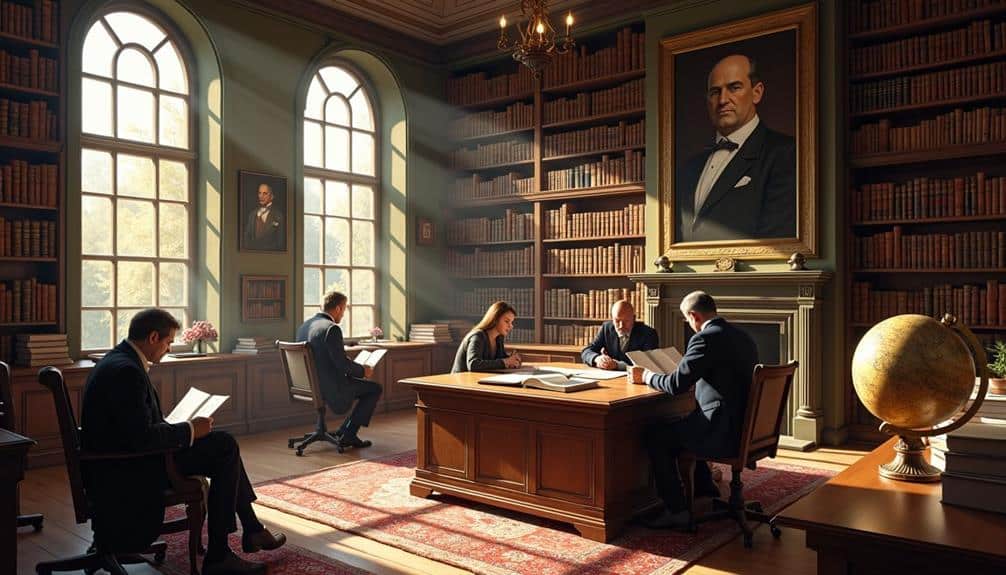When you think about the global impact of literary giants, Leo Tolstoy’s name undoubtedly comes to mind. His innovative narrative techniques and intricate character development have set a benchmark in storytelling that transcends cultural boundaries. You’re likely familiar with “War and Peace” and “Anna Karenina,” but have you ever considered how Tolstoy’s exploration of moral dilemmas and incisive social commentary continues to influence contemporary writers? His works don’t just reflect 19th-century Russian society; they serve as a cornerstone for modern literature, prompting you to question how deeply his themes resonate with today’s diverse audiences.
Tolstoy’s Narrative Techniques

Tolstoy’s narrative techniques are a masterclass in blending depth with readability, captivating readers from the outset. One of his standout methods is the stream of consciousness, which immerses you in the inner workings of his characters’ minds. This technique allows you to experience thoughts, feelings, and perceptions directly, creating an intimate connection with the narrative. By employing stream of consciousness, Tolstoy ensures that you’re not just reading about events; you’re experiencing them as the characters do.
The narrative structure in Tolstoy’s works is equally compelling. He skillfully interweaves multiple plotlines, reflecting the complexity of real life. This layered structure demands your attention and rewards you with a richer understanding of the story’s themes.
By juxtaposing different story arcs, Tolstoy creates a tapestry of interrelated events that mirror the interconnectedness of human experiences. This method also allows for a more dynamic and engaging reading experience, as you’re constantly shifting perspectives and gaining new insights.
In combining these techniques, Tolstoy masterfully balances depth with accessibility, making his narratives both profound and approachable. His innovative use of stream of consciousness and intricate narrative structure sets a high standard in literary tradition, inviting you to delve deeply into his world.
Character Complexity
In exploring character complexity, you’ll find that Russian authors, particularly Leo Tolstoy, excel in creating multifaceted individuals that resonate with readers on a profound level.
Tolstoy’s characters aren’t merely vessels for the plot but embodiments of psychological depth and authentic human experience. This intricacy in character portrayal allows readers to connect deeply with the individuals that populate his narratives.
Tolstoy’s mastery lies in his ability to depict character evolution. Through his detailed exploration of their internal and external lives, you witness their growth, struggles, and transformations.
For instance, in “War and Peace,” characters like Pierre Bezukhov and Prince Andrei Bolkonsky are presented with immense psychological depth. Their journeys are marked by significant personal changes, influenced by the tumultuous events around them.
This evolution isn’t linear but filled with contradictions and complexities, mirroring real human development.
Social Commentary

Russian literature is replete with profound social commentary, providing readers not only with engrossing narratives but also with incisive observations on societal structures and human behavior.
When you delve into the works of renowned Russian authors like Tolstoy, you’re met with a rich tapestry of historical context that reveals the intricacies of Russian society. Tolstoy, for instance, uses his novels to critique the vast disparities between the aristocracy and the peasantry, shedding light on the inequities that permeated 19th-century Russian life.
By examining these texts, you gain insight into the systemic issues that plagued Russia, such as serfdom and the rigid class hierarchy. The societal critique embedded in these narratives isn’t confined to Russia alone; it resonates with global themes of oppression, inequality, and the quest for social justice.
When you read Tolstoy’s “War and Peace” or “Anna Karenina”, you’re not simply engaging with fiction but also with a dissection of the human condition within a specific historical context.
This blend of storytelling and social commentary has influenced literary traditions worldwide, encouraging authors to weave societal critique into their narratives, thereby enriching the global literary landscape.
Philosophical Themes
While the social commentary in Russian literature provides a critical lens on societal structures, philosophical themes offer a deeper exploration of existential questions and human nature. When you delve into the works of Russian authors like Tolstoy, you encounter a profound engagement with the human condition.
Tolstoy’s narratives are imbued with ethical reflections, compelling you to ponder the moral dimensions of human actions. Take, for instance, “War and Peace,” where Tolstoy doesn’t just recount historical events but probes the essence of free will, fate, and the individual’s role in shaping history. His characters wrestle with existential questions, navigating the complexities of life and death, love and duty, faith and doubt. You’re invited to reflect on your own existence, grappling with similar dilemmas.
Furthermore, Tolstoy’s later works, such as “The Death of Ivan Ilyich,” confront the inevitability of mortality and the search for meaning in life. The protagonist’s journey forces you to consider what truly matters, pushing you towards introspection.
Through these philosophical themes, Russian literature doesn’t just entertain; it challenges you to think critically about life’s fundamental questions and ethical decisions.
Global Literary Influence

The reach of Russian literature extends far beyond its geographical borders, establishing itself as a cornerstone in the global literary canon. You can see this influence manifest through cultural exchange and literary adaptation, where Russian storytelling traditions blend seamlessly with those from other cultures. This thematic universality ensures that the works resonate with a global readership, transcending language and historical context.
However, translation challenges can’t be overlooked. Translators must capture the essence of Russian narrative styles, which often include complex characters and intricate plots. This difficulty sometimes leads to variations in critical reception, as nuances may be lost or altered. Despite these challenges, the thematic depth of Russian literature, such as its exploration of human nature and societal issues, remains impactful.
Moreover, Russian works often engage in genre blending, merging elements of realism, philosophy, and drama. This versatility has inspired countless adaptations and influenced global literary traditions.
In examining the historical context of these works, you appreciate their role in shaping both contemporary and classical storytelling methods. Ultimately, the global literary influence of Russian authors is a testament to their enduring relevance and profound impact on world literature.
Tolstoy’s Literary Legacy
Few literary figures have left as indelible a mark on the world as Leo Tolstoy. His works, deeply embedded in their historical context, offer you a profound understanding of 19th-century Russian society.
Tolstoy’s novels, notably “War and Peace” and “Anna Karenina,” transcend mere storytelling to present intricate examinations of human nature and societal structures. By delving into these texts, you gain insights into the complexities of Russian aristocracy, serfdom, and the Napoleonic wars.
Tolstoy’s personal letters reveal his evolving philosophical beliefs and provide a window into his creative process. These correspondences are invaluable for understanding the man behind the masterpieces.
They show his grappling with issues like morality, spirituality, and the human condition, which are pervasive themes in his literature. His letters to contemporaries, such as Nikolai Strakhov and Ivan Turgenev, illustrate his intellectual rigor and the collaborative nature of his literary endeavors.
Realism in Literature

Realism in literature, an influential movement that emerged in the mid-19th century, sought to depict life with fidelity and authenticity. You’ll find that this movement diverged sharply from the romanticized and exaggerated narratives that preceded it.
Realist authors aimed to portray everyday experiences, societal issues, and human conditions with unembellished detail. A critical aspect of realism is its focus on psychological depth.
Authors like Tolstoy excelled in exploring the inner lives of their characters, presenting their thoughts, motivations, and moral dilemmas with remarkable nuance. This psychological exploration adds layers of complexity to the narrative, inviting you to engage with characters on a profoundly intimate level.
Emotional realism, another cornerstone of this movement, ensures that the characters’ emotions and reactions are genuine and relatable. By delving into the authentic emotional states of characters, realist literature provides a mirror to your own experiences and emotions, fostering a deeper connection with the text.
Influence on Modern Authors
Tolstoy’s masterful exploration of psychological depth and emotional authenticity didn’t just define realism; it laid the groundwork for modern literary techniques. When you delve into contemporary literature, you can trace Tolstoy’s influence in the intricate character development and thematic exploration that push the boundaries of modern storytelling.
Authors today draw upon his narrative innovation, weaving complex emotional landscapes and existential questions into their works. You can see Tolstoy’s impact in the narrative voice of modern authors who strive for authenticity and emotional depth.
His approach to character development—where characters are multifaceted and grappling with internal conflicts—has become a benchmark for literary adaptation across genres. This cross-genre influence allows contemporary writers to reflect cultural nuances and delve into the human condition with remarkable precision.
Moreover, Tolstoy’s exploration of existential questions permeates modern literature, prompting authors to examine life’s profound uncertainties. His legacy is evident in the way modern authors use narrative voice to probe deep psychological and emotional truths, creating stories that resonate on a deeply human level.
Moral Dilemmas

Moral dilemmas in Russian literature are a profound exploration of the human psyche, often revealing the complex interplay between individual conscience and societal norms. When you delve into works by authors like Tolstoy, you’re not just reading about characters; you’re engaging with ethical conflicts that challenge the essence of human morality.
Tolstoy’s “Anna Karenina,” for example, presents you with existential choices that force you to weigh personal happiness against societal expectations.
These moral quandaries aren’t confined to Tolstoy. Dostoevsky’s “Crime and Punishment” immerses you in Raskolnikov’s struggle with guilt and redemption, questioning the legitimacy of utilitarian ethics. The protagonists are often placed in extreme situations where their decisions reflect broader philosophical inquiries.
You’ll find that these narratives compel you to confront your own beliefs, prompting introspection.
The intensity of these ethical conflicts is what makes Russian literature uniquely impactful. By pushing characters to the brink of moral collapse, writers like Tolstoy and Dostoevsky illuminate the profound depths of human suffering and resilience.
These existential choices resonate deeply, making you question the very foundations of right and wrong within the human experience.
Cross-Cultural Resonance
The exploration of moral dilemmas in Russian literature often transcends cultural boundaries, resonating with readers from diverse backgrounds. When you delve into Tolstoy’s “War and Peace” or Dostoevsky’s “Crime and Punishment,” you encounter themes that speak to universal human experiences. These works facilitate cultural exchange, allowing readers worldwide to grapple with ethical questions and existential crises, regardless of their cultural context.
Russian literature’s profound impact on global literary traditions lies in its ability to be adapted across cultures. Literary adaptation of Russian narratives into various languages and cultural settings demonstrates their universal appeal. You see Tolstoy’s exploration of human nature reflected in adaptations ranging from Japanese cinema to American theater. This cross-cultural resonance underscores the shared human condition, bridging gaps between disparate societies.
Moreover, the philosophical inquiries posed by Russian authors invite readers to engage in introspective reflection, fostering a deeper understanding of their own cultural and moral frameworks. As you read these Russian classics, you’re not merely engaging with another culture; you’re participating in a global dialogue on the human experience.
This cultural exchange enriches your perspective, highlighting the interconnectedness of literary traditions worldwide.




